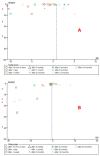Effect of Fixed Orthodontic Treatment on Salivary Nickel and Chromium Levels: A Systematic Review and Meta-Analysis of Observational Studies
- PMID: 30823648
- PMCID: PMC6473672
- DOI: 10.3390/dj7010021
Effect of Fixed Orthodontic Treatment on Salivary Nickel and Chromium Levels: A Systematic Review and Meta-Analysis of Observational Studies
Abstract
Nickel and chromium ions released from fixed orthodontic appliances may act as allergens. This study aimed to systematically review the effect of fixed orthodontic treatment on salivary levels of these ions by doing a meta-analysis on cross-sectional and cohort studies. The Web of Science, Scopus, Cochrane Library, and PubMed databases were searched for articles on salivary profile of nickel or chromium in patients under fixed orthodontic treatment published from January 1983 to October 2017. A random-effect meta-analysis was done using Review Manager 5.3 to calculate mean difference (MD) and 95% confidence interval (CI), and the quality of questionnaire was evaluated by the Newcastle⁻Ottawa scale. Fourteen studies were included and analyzed in this meta-analysis. Salivary nickel level was higher in periods of 10 min or less (MD = -11.5 µg/L, 95% CI = -16.92 to -6.07; P < 0.0001) and one day (MD = -1.38 µg/L, 95% CI = -1.97 to -0.80; P < 0.00001) after initiation of treatment compared to baseline (before the insertion of appliance). Salivary chromium level was higher in periods of one day (MD = -6.25 µg/L, 95% CI = -12.00 to -0.49; P = 0.03) and one week (MD = -2.07 µg/L, 95% CI = -3.88 to -0.26; P = 0.03) after the initiation of treatment compared to baseline. Corrosion of fixed orthodontic appliances leads to elevated salivary nickel and chromium concentrations early after initiation of orthodontic treatment. Randomized clinical trials controlling for factors affecting the saliva composition are recommended on a higher number of patients and among different ethnicities.
Keywords: Orthodontic appliances; chromium; meta-analysis; nickel; saliva.
Conflict of interest statement
The authors declare no conflict of interest.
Figures







References
Publication types
Grants and funding
LinkOut - more resources
Full Text Sources

